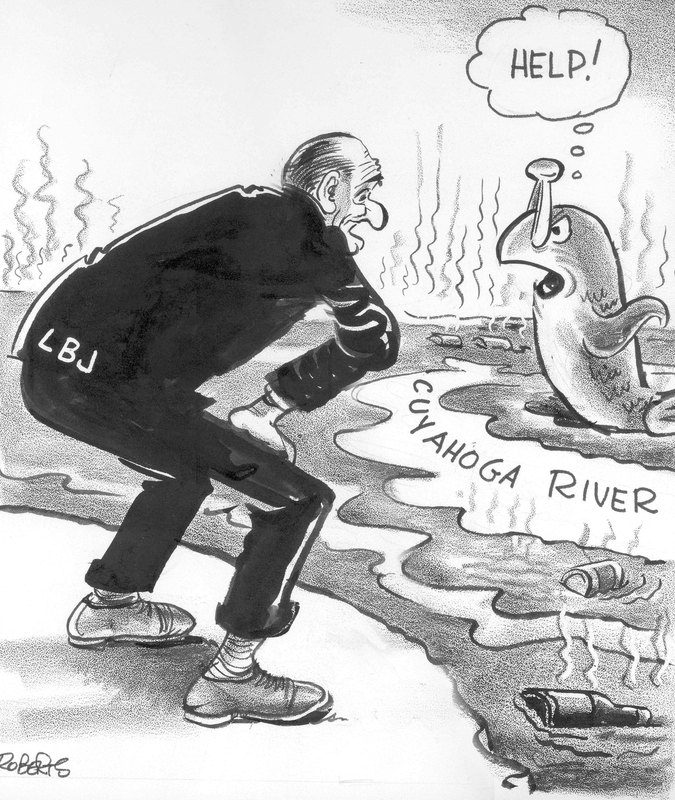40th anniversary of the Clean Water Act
by Liza Lester, ESA communications officer
“Help!” 1969. Cleveland State University Library Special Collections. Cleveland Press Collection. Bill Roberts Editorial Cartoon Collection. Roberts0706. By 1969, there had long been no fish left in the Cuyahoga to plead for help, according to a Time magazine article that ran that August, and commented, memorably, “Some River! Chocolate-brown, oily, bubbling with subsurface gases, it oozes rather than flows.”
ON the afternoon of June 22, 1969, the Cuyahoga River was on fire. It wasn’t the first time; the river had burned in Cleveland on 13 occasions over the previous century. This was just a little flare up, of no particular note, put out in less than half an hour by the local fire department. Nothing like the 1952 blaze that burned through three days, a bridge, and a fleet of fishing vessels, to the tune of $1.5 million.
But people did notice. Time magazine noticed, and Washington noticed. Americans, seeing the costs of pollution, were mobilizing for change. The stage was set for the Clean Water Act.
Though he supported the Clean Air Act and set up the Environmental Protection Agency in 1970, President Nixon vetoed the Clean Water Act when it arrived on his desk two years later, complaining of its bloated $24 billion price tag and retroactive payments to state and local governments for sewer upgrades already completed. The water quality bill he sent to Congress, he wrote, would get the job done in a fiscally responsible manner.
“It would have committed $6 billion in Federal funds over a three-year period, enough to continue and accelerate the momentum toward that high standard of cleanliness which all of us want in America’s waters,” he told Congress in his veto statement. “I have nailed my colors to the mast on this issue. The political winds can blow where they may. I am prepared for the possibility that my action on this bill may be overridden.”
Congress did overrule him, voting the Clean Water Act into law on October 18, 1972. But it took the Impoundment Act of 1974 and a Supreme Court ruling to get him to spend all of the money Congress appropriated for the purpose.
US rivers do not run thick with oil anymore, thanks to the Clean Water Act, the EPA, and other environmental policies of the 1970s. The Clean Water Act has been very effective at cleaning up point sources of pollution to the “navigable waters” in it’s purview, sources like municipal sewers and stormdrains, stockyards, and refineries (ephemeral water bodies like seasonal rivers, playa lakes, and wetlands disconnected from a “significant nexus” with a navigable waterway are not protected, per the 2006 Supreme Court ruling in Rapanos v. United States). Agricultural runoff has been a stickier problem. Exemptions to the Clean Water Act and Safe Drinking Water Act (which covers groundwater) for hydraulic fracking have ignited debate in the eastern US in the last few years.
- The LA Times is celebrating the anniversary with an Op-Ed on the need for upgrades: “Refreshing the Clean Water Act.” Mark Gold 17 Oct 2012
- Oregon Public Radio has been running a series on clean water.
- EPA has a page dedicated to the anniversary and why “Water is Worth it.”
